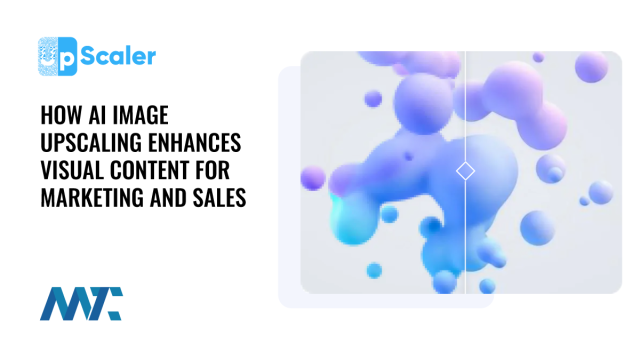It’s a crowded digital world where visuals are doing most of the talking. If you’re running ads, launching a landing page, or sending out an email campaign, the quality of your images can make or break the first impression.
While marketers have long relied on catchy headlines and clever targeting, visuals remain the first thing people notice. That’s why more marketing teams are now using artificial intelligence not just for automation or copywriting — but for enhancing their visual assets.
One of the smartest techniques gaining ground is using AI to upscale image quality without losing natural detail.
Why Sharp Visuals Matter in Marketing
Strong visuals aren’t just a nice extra anymore — they’re a core part of any effective marketing strategy.
They help you:
Grab attention faster in busy feeds and crowded inboxes.
Build credibility and trust within seconds.
Keep bounce rates lower on landing pages.
Increase conversion rates on sales and product pages.
Improve SEO through optimized image delivery and faster site speed.
First impressions are ruthless. Studies show it takes just 50 milliseconds for someone to form an opinion about a brand, often based purely on design and visuals. No matter how compelling your offer is, pixelated or blurry imagery can silently undermine your efforts.
As screen resolutions continue to climb — from retina laptops to 4K smartphones — the expectation for crisp, detailed visuals grows even higher.
What Is AI-Based Image Upscaling?
AI-based image upscaling differs from simply resizing an image in Photoshop. Instead of simply stretching pixels, these tools use deep learning models to:
Analyze patterns, edges, and textures.
Predict how finer details should look.
Rebuild missing information naturally, without the ugly artifacts traditional upscaling often causes.
With AI, a small or slightly blurry photo can be restored to look sharp, professional, and ready for high-impact use.
Solutions like upscale image allow marketers to quickly improve their visual materials without needing a graphic design degree or costly reshoots.
How Marketing Teams Are Using Upscaled Images
Here are a few real-world ways brands are putting AI-powered upscaling to work:
Paid Ads: Crisp visuals improve ad relevance scores on platforms like Facebook and Google, reducing cost-per-click (CPC).
Social Media: Enhanced images maintain quality even when compressed by Instagram, LinkedIn, or Pinterest algorithms.
Email Campaigns: High-resolution banners and thumbnails increase open and engagement rates.
Product Listings: E-commerce brands upscale product shots for Amazon, Etsy, or Shopify listings, where tiny visual flaws can hurt conversions.
Sales Enablement: Upscaled visuals in proposals and pitch decks create a stronger, more polished impression during buyer presentations.
Webinars and Events: Event marketing assets, like speaker promos or session banners, look sharper and more professional.
In each case, it’s not about adding flashy effects — it’s about making sure every image is clean, clear, and credible.
Why AI Is Better Than Traditional Editing Tools
Sure, you could use Photoshop or another editing tool to manually tweak images.
But traditional editors:
Struggle when asked to dramatically boost resolution.
Often introduces blurriness or distortion.
Require manual, time-consuming adjustments by a skilled designer.
AI solutions like upscale image tools solve these issues by:
Saving marketers hours of editing work.
Producing better, sharper results at any size.
Helping teams stay on brand without bottlenecks in production.
Integrating easily into your existing marketing stack.
With these advantages, AI-based image enhancement is quietly becoming a standard practice for high-performing marketing teams.
Best Practices for Upscaling Marketing Images
If you’re planning to integrate AI image upscaling into your content workflow, here are a few tips to get the best results:
Choose the highest-quality source possible: Upscaling can’t entirely fix a bad photo, but it can elevate a decent one to great.
Think about the context: Upscaling a thumbnail for a blog post differs from preparing an image for a printed trade show banner.
Balance file size and quality: After enhancement, compress your images carefully to keep load times fast without noticeable quality loss.
Review across devices: Test your images on mobile, tablet, and desktop to make sure they shine everywhere.
Pro Tip: For web assets, exporting in WebP format after upscaling often strikes the perfect balance between speed and fidelity.
Potential Pitfalls to Avoid
Even with AI tools, marketers should watch out for:
Over-sharpening: Sometimes, automated tools can make an image look unnatural if pushed too far.
Over-reliance: Upscaling works best when combined with good visual selection — AI can enhance, but it can’t replace good creative judgment.
Neglecting Mobile Optimization: An upscaled image that’s perfect for desktop may still need tweaks for smaller screens.
Being mindful of these factors ensures that enhanced visuals truly add value, not just file size.
Conclusion
If you’re serious about staying competitive, it’s worth taking a closer look at AI-powered ways to upscale image quality. Sharper, smarter visuals don’t just look better — they drive more engagement, build stronger brands, and lead to higher conversions.
Tools like Image Upscaler make it easy to improve your content without exploding your timeline or budget. It’s one of those small upgrades that quietly amplifies everything you do — from social media to sales decks and everything in between.
As marketing becomes even more visually driven in the years ahead, having AI upscaling in your toolkit isn’t just smart — it’s essential.
©2025 DK New Media, LLC, All rights reserved | Disclosure
Originally Published on Martech Zone: How AI Image Upscaling Enhances Visual Content for Marketing and Sales

